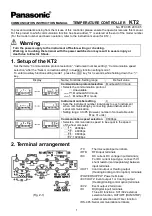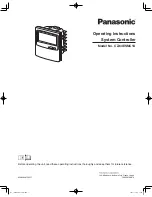
-
7
-
«Translated from original instructions»
THIS DOCUMENT PROVIDES THE INSTRUCTIONS FOR THE
INSTALLATION, USE AND MAINTENANCE OF THE VALVE,
THEREFORE IT IS AN INTEGRAL PART OF THE VALVE ITSELF
AND MUST BE READ CAREFULLY BEFORE ANY USE AND
KEPT WITH CARE.
STRICTLY COMPLY WITH THE INSTRUCTIONS CONTAINED IN
THIS DOCUMENT IN VIEW OF A SAFE AND EFFECTIVE USE OF
THE VALVE.
FAILURE TO COMPLY WITH THESE INSTRUCTIONS MIGHT
CAUSE EARLY FAULTS AND RESULT IN SITUATIONS OF
DANGER, IN ADDITION TO VOIDING ANY WARRANTY.
1- GENERAL INFORMATION
1.1- The PNR1510 pressure regulator is a manually-adjustable,
pressure-operated pneumatic-control device. According to its setting,
this device limits the pump/system pressure by conveying the excess
of water to the by-pass.
Moreover, when the outlet flow is blocked, it totally releases the flow,
thus keeping the pump/system at the adjusted pressure.
1.2- The pneumatic control of the valve allows to change the
hydraulic working pressure by changing the air pressure. The two
pressures are proportional, i.e. when increasing the pneumatic
pressure the hydraulic pressure increases and when reducing the
pneumatic pressure the hydraulic pressure decreases (see table A).
1.3- The pneumatic control of the valve allows to cut in or to cut out
the adjusted hydraulic pressure. This function is particularly suited for
automatic working cycles and remote controls. When the hydraulic
pressure is cut out, the pump starts at zero pressure, i.e. without the
motor being under stress.
1.4- In order to operate the pneumatic control of the valve it is
necessary to use compressed air with a value depending on the
desired hydraulic pressure. In order to correctly operate the
pneumatic control we suggest you use a 3/2-way valve and a
pressure regulator as shown in the diagram (table B).
1.5- Since the PNR1510 valve is used in connection with a high
pressure water pump/system, which shall be called hereafter only
“system”, installation and use must be suited to the type of system
used and comply with the safety Regulations in force in the Country
where the valve is used.
1.6- Before using the valve, make sure that the system the valve is
used with is certified to comply with the relevant Directives and/or
Regulations.
1.7- Before installing and using the valve for the first time, we
suggest you check that it is undamaged and make sure that the rated
features correspond to the required ones. If this is not the case, do
not use the valve and contact the after-sales service of Interpump
Group for information.
1.8 - In order to install the valve correctly, follow the instructions for
the water inlet, outlet and by-pass connections, as stated in this
instruction manual and/or on the valve itself.
2- PACKAGE
2.1- Packages must be handled in compliance with the instructions
stated on the packages themselves and/or provided by the
manufacturer.
2.2- In case the valve is not used immediately, it must be stored in its
integral package and placed in areas which are not exposed to the
weather and protected from excessive humidity and from direct
sunlight. Moreover, it is advisable to place wooden pallets or other
types of pallets between the package and the floor, in order to prevent
the direct contact with the ground.
2.3- The package components must be disposed of in compliance
with the relevant laws in force.
2.4- Take great care when lifting and handling the valve during
installation and avoid any sudden accelerations or changes of
direction. Also avoid any excessive oscillations and keep the valve
upright in order to prevent any loss of stability and the possibility of
overturns.
2.5- To lift the valve, use tools such as snap-hooks, straps, ropes,
hooks etc., which must be certified and suited for the mass to be
lifted. The valve mass is stated in the table of technical features.
3- INSTRUCTIONS FOR INSTALLATION AND PRESSURE
SETTING:
The positions mentioned in the following instructions refer to those
shown in the spare parts catalogue (page 3).
3.1- Installation
3.1.1- Fit the O-Ring pos. 39 into the seat of the valve body pos. 14.
3.1.2- Set the valve on the pump head taking care that the O-Ring
pos. 39 stays in place correctly.
3.1.3- Slightly lubricate the threads of the four screws pos. 49 with
Lithium grease and tighten by means of a dynamometric wrench
(torque wrench setting as stated in the exploded view – page 3).
3.2- In order to obtain a correct adjustment and consequently a
proper functioning of the valve, always make sure that, when working
at the maximum pressure, the valve by-pass keeps releasing a
quantity of water equal to 5% of the total flow-rate. In case the flow-
rate at the by-pass is close to zero or exceeds 15% of the maximum
flow-rate, this could cause faults, early wear and result in situations of
danger.
3.3- Connect the valve to the water system and to the pneumatic
circuit, then follow these steps:
3.4- Pressure setting
3.4.1- Open the pneumatic pressure regulator completely in order to
control the valve.
3.4.2- Start the hydraulic system on which the valve is fitted and
make sure that the air contained in it is fully ejected.
3.4.3- Open the gun or the water control device. Start the pneumatic
circuit and begin adjusting the air pressure within the valve by using
the pneumatic pressure regulator. Alternate the adjusting operations
with a few openings and closings of the gun or of the control device.
When the desired hydraulic pressure has been reached, open and
close the gun/control device a few times again in order to stabilize
the various components (seals, springs etc.). Check the pressure
value again and correct if necessary.
3.4.4- In case you decide to change the adjusted hydraulic pressure
later, follow the procedure stated in paragraph 3.4.3 again.
3.5-
The maximum pneumatic pressure allowed within the
PNR1510 valve must not exceed the below-mentioned
values:
PNR1510 = max. air pressure 0.75 MPa (7.5 bar)
= ENGLISH =
TECHNICAL FEATURES
Max FLOW RATE
Max PRESSURE
Max
TEMPERATURE
MASS
MODEL
L/min
g.p.m.
(USA)
MPa
bar
p.s.i.
°C
°F
kg
lbs
PNR1510
100
24.4
150 1500 21755
30
70
13.5 29.7


































